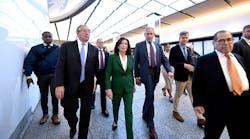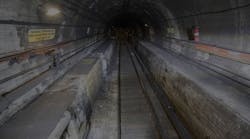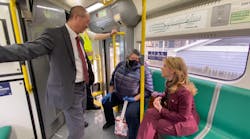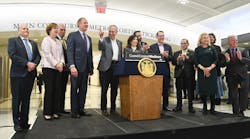OP-ED: Challenges ahead for new interim LIRR President Robert Free
The appointment of Metropolitan Transportation Authority's (MTA) Long Island Rail Road (LIRR) Senior Vice President of Operations Robert Free as interim LIRR president by MTA Chairman Janno Lieber is a refreshing selection. This was probably first run by New York Gov. Kathy Hochul for her blessing. There was always no way Acting LIRR President Catherine Rinaldi could give her full attention to this critical full-time position. There was never enough hours in the day while wearing two hats. Rinaldi also served as Metro-North Railroad president.
The same should apply to Free. He should promote his deputy or second in command to fill his shoes and become acting LIRR vice president of operations. This way, Free can devote 100 percent of his time managing the nation's largest commuter railroad.
Promoting from within the LIRR senior organization management team makes sense. Rather than wasting time and money in a national search for a new permanent LIRR president, Lieber should promote from within. Besides Free, there are a number of very capable other senior LIRR vice presidents such as Executive Vice President Elisa Picca, Senior Chief Engineer Ed McGoldrick and several others who could easily step in to fill this position full time. They, like Free, already have a good understanding of the LIRR's organization, staff, operations, facilities and customers needs. Any would be able to hit the job running with little need for on the job training.
Free may need to become more familiar with planned future capital projects and programs in coming years. This should include a briefing by MTA headquarters staff assigned to complete the MTA 2025 - 2044 Twenty Year Capital Needs Plan. Port Washington branch riders will be interested in learning if this will include $40 million for reopening the Elmhurst station closed in 1982. Port Jefferson branch commuters want to know if the $3.5 billion double tracking electrification project between Huntington and Port Jefferson station is also included.
Free should also be briefed on the status of previous unfulfilled promised commitments by both former LIRR President Phil Eng and outgoing interim LIRR President Rinaldi. It should include the critical potential for electrification of all diesel territory branches study. This feasibility study began under Eng three years ago. To the best of my knowledge, it was never completed and made public.
Free will need to meet the challenge of excessive overtime for LIRR's share of a record MTA $1.3 billion in 2022. It continues to grow in 2023. His immediate predecessors, Rinaldi (2022 - 2023) and Eng (2018 - 2022), both failed to significantly reduce excessive employee overtime.
Every generation of previous LIRR presidents since the 1980s has made the wrong choice. They believed it would be cheaper to pay overtime than hire additional employees, whose critical specialized skills were necessary for maintaining functioning safe and reliable transportation operations. They thought it would be less expensive by avoiding the costs of training, full time salary plus fringe, medical insurance and pensions by not increasing the headcounts of various departments. This has contributed to excessive overtime expenses.
There is a difference between necessary overtime due to malfunctioning equipment, accidents or adverse weather conditions when attempting to restore service, versus others. With the addition of East Side Access to Grand Central Madison via the 63rd Street Tunnel, Main Line Third Track, completion of double tracking the Ronkonkoma branch and other service improvements, it is time to revisit this issue. It may make sense to hire more full-time new employees rather than year after year paying for excessive overtime.
There is still the need to deal with significant overtime abuse and out of control pensions. Employees with seniority in their last year of employment enjoy excessive overtime. This results in record pensions upon retirement the following year. MTA management needs to reduce mandatory excessive overtime and double shifts to complete capital projects.
Free also needs to deal with the LIRR share of MTA's ongoing fare evasion. It continues to be difficult to collect fares periodically during rush hour or major sporting events when riders are standing in the aisles and vestibules. Ditto when trains are combined and cancelled. There is no room for conductors to walk through the train and collect fares.
Ongoing cancellation and combining of trains due to signal and other problems in the East River tunnels, along with other locations on all nine branches of the LIRR system, still needs to be dealt with. It will continue for years to come and may grow worse. Amtrak will actually begin initiation of decades overdue major repairs of the East River tunnels some time in 2024.
This work on all four tunnels is less than a year away, including two that suffered significant damages from 2012 Super Storm Sandy. It will not be completed until 2027. Amtrak has said that these two tunnels will require a minimum of one year each for completion. It will require one of two tunnels damaged by Super Storm Sandy being out of service at a time for one year to support this work. The other two tunnels will need similar work.
With only three of four tunnels available, there will be a reduction in Penn Station access and capacity. To preserve existing service, many LIRR rush hour trains will be canceled or combined. Until this work is over, it will be impossible to guarantee safe and reliable on time service to Penn Station for LIRR commuters.
Reduced East River tunnel capacity makes it difficult to add previously promised new services This includes Metro-North Rail Road East Bronx New Haven line Access to Penn Station and 50 percent overall increase in reverse peak service after opening of East Side Access to Grand Central Madison. Both Amtrak and New Jersey Transit need access to the Queens Sunnyside Yards via the East River tunnels to support their own respective planned service increases.
Going from four to three available East River tunnels results in a significant capacity reduction. This translates to no increase in existing or new services until work on all four East River tunnels is completed. The LIRR needs to develop a new Penn Station service plan and make it public to riders prior to Amtrak initiating this work.
Free will need to develop a relationship with the Federal Transit Administration (FTA) Region 2 New York office. It is critical. He should make it a priority to meet with the FTA New York Region 2 Office Administrator and staff. The FTA provides significant annual capital grants to the LIRR via MTA headquarters. Free should quickly come up to speed with LIRR's FTA federal fiscal year 2023 and future 2024 Program of Projects for the various FTA grant programs. This is accomplished under the FTA Transit Award Management System (known as "TrAMS") that is used to award and manage federal grants.
As part of the requirements contained within all master grant agreements, using the FTA TrAMS System, the LIRR via MTA headquarters provides updated Quarterly Financial and Milestone Progress Reports to the FTA on active capital improvement projects and programs. Free should become familiar with the contents of these reports.
Information contained includes status of capital project contract award or initiation of in house projects. He can learn if projects and programs are progressing on schedule, completed on time and within budget, based upon the original approved grant milestones and budget. Explanations for project delays and change orders for more than $100,000 are provided. Project delays require recovery schedules and revised interim milestones to document future completion.
The FTA has its own Project Management Oversight (PMO). PMO's are independent engineering consultant firms to supplement regional and headquarters staff for oversight. These firms provide both oversight and technical assistance for capital projects. FTA Region 1 will usually assign their own engineering consultant firms to those projects $100 million or more. Engineering firms monitor the progress of these major capital projects and prepare monthly progress reports. Free should become familiar with the contents of these reports. He needs to make it a priority to meet with the FTA PMO employees assigned to manage the LIRR.
The FTA also has other consulting firms who conduct periodic Financial Management, Procurement System and Triennial (to insure compliance with FTA rules and regulations) along with various Civil Rights (Title VI, Disadvantaged Business Enterprise, Equal Opportunity Employment, Americans With Disabilities, Rail Station, Fixed Bus Route and Paratransit reviews). Free should become familiar with the contents of these reports. He should take a personal interest and become involved in any future reviews and follow up with his own staff to insure any open findings from previous reviews are closed as quickly as possible.
Timely access to FTA formula and national competitive discretionary grant programs will continue to play a critical role in assisting the LIRR reaching a state of good repair for existing fleet, stations, signals, interlocking's, track, power, yards and shops. Expanding the number of stations that are in compliance with ADA is another priority. Ensuring that maintenance programs for all assets are fully funded and completed on time to so riders get safe and reliable service.
Completing capital projects on time, within budget with a minimum of justified contract change orders will help build Frees credibility with FTA , Albany, other funding agencies, Long Island commuters, Queens, Nassau and Suffolk county, state and federal elected officials, taxpayers and transit advocacy groups.

Larry Penner
Larry Penner is a transportation advocate, historian and writer who previously served as a former director for the Federal Transit Administration Region 2 New York Office of Operations and Program Management. This included the development, review, approval and oversight for billions in capital projects and programs for New Jersey Transit, New York Metropolitan Transportation Authority, NYC Transit bus, subway and Staten Island Railway, Long Island and Metro North railroads, MTA Bus, NYCDOT Staten Island Ferry along with 30 other transit agencies in New York and New Jersey.






